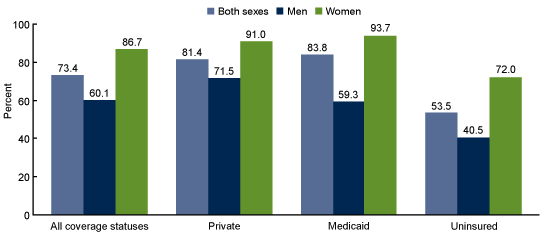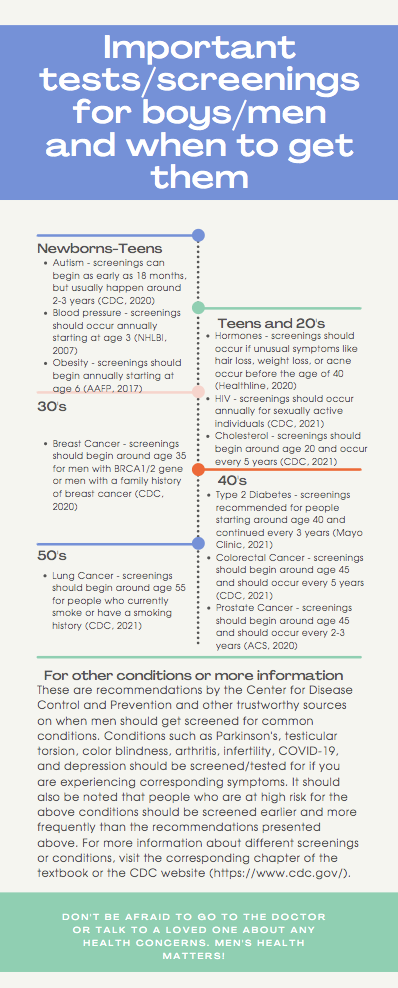Cary Andreo
Introduction
It is well known by most that women, on average, tend to live longer than men in almost every country in the world (Bulletin of the World Health Organization, 2014). One reason for this age gap is that men account for 95% of all workplace injuries and deaths (Bulletin of the World Health Organization, 2014), but this is only a small part of the problem. Men’s health is an issue that has been overlooked in most societies around the world for many years. Men are twice as likely to go two or more years without going to the doctor (International Journal of Men’s Health, 2003), and it was previously thought that women just overused health services. It is now understood that men severely underuse health services that are available to them. This leads to the question: “why don’t men seek help”? The way masculinity is defined in society has a big impact on how often men seek help from health services. There are also different populations that are most at risk of ignoring health services. Understanding these factors can lead to solutions to this men’s health issue.
Masculinity in Our Society
Masculinity is defined as the quality or nature of the male sex, which can vary in many different cultures for a number of reasons. Across different cultures, masculinity is usually defined by the thoughts of the most common racial, socioeconomic, and religious subcultures (American Journal of Men’s Health, 2019) alongside how it is portrayed in mainstream media like movies, television shows, and sports (The Media and Models of Masculinity, 2012). Masculinity in these subcultures and in Western media is portrayed as powerful, aggressive, self-reliant, and emotionless. One of the best examples of someone who portrays masculinity with all of the above characteristics is James Bond, and those movies have been extremely popular for many decades. These group norms are very significant because conformity to a group norm is a very powerful predictor of behavior (International Journal of Men’s Health, 2003). In other words, people are likely to believe and act as most other people do.
Why Men Don’t Seek Help
Since masculinity is considered the norm, it is seen as ‘weak’ to use healthcare services for different illnesses or conditions, especially if these conditions interfere with everyday tasks, like depression (US News, 2018). Seeking help from a health professional might be frowned upon by some people because they believe men are supposed to be the strong head of the family. This may cause men to perceive that going to the doctor portrays this “weakness”, therefore leading to them ignoring the health problem. Men generally don’t go to the doctor at all until they have a severe issue that has a negative impact on many aspects of their lives. Because of this, they don’t go to the doctor until the problem is already irreversible. Since men do not seek professional help as much, they tend to turn to other, more ‘masculine’, coping strategies like drugs or alcohol, which can create further problems (American Journal of Men’s Health, 2011).
“Percentage of Adults Age 20-29 Who Had a Doctors Visit in the Past Year” by Dr. Robin A. Cohen is in the Public Domain
Populations at Risk
Black men were less likely to use healthcare than other ethnicities, and unmarried men were less likely to use healthcare than married men (American Journal of Men’s Health, 2011). Black men were less likely to go to the doctor since there tended to be an even greater emphasis of strength involved with the role of a man in Black families. Married men go to the doctor more often than unmarried men because a spouse, oftentimes, is able to persuade their husband that they need to seek professional help.
How to Fight the Issue
The first step is to help fight resistance for medical care, which can be done by recognizing the issue and having conversations about it. Advocating for men’s health and positive masculinity in the media is a beneficial step that must be taken. Talking to men outside of a clinical setting and finding out who they are comfortable talking to is a great way to break the help-seeking barriers that many men face (Psychiatry Advisor, 2017). In order to close the life expectancy gap between men and women, everyone should encourage men to take disease preventative steps and learn to recognize health conditions symptoms including the ones described in this book. This is a very serious issue, but as conversations about it continue, it can definitely become less of a problem.
Chapter Review Questions
1. What race or ethnicity is most likely to not seek medical help?
A. White
B. Black
C. Hispanic
D. Asian
2. Which of the following is not an effective way to break help-seeking barriers for men?
A. Continue conversations about how important help-seeking is
B. Find out who men might be comfortable talking to about help-seeking
C. Educate men on the importance of help-seeking
D. Tell them to ‘man up’ and go seek help
3. Which of the following coping strategies that men can use is harmful?
A. Abusing drugs or alcohol
B. Talking to friends or loved ones
C. Becoming part of an anonymous support group
D. Seeking help from a professional
References
American Cancer Society. (November 17, 2020). American Cancer Society recommendations for prostate cancer early detection. Retrieved from https://www.cancer.org/cancer/prostate-cancer/detection-diagnosis-staging/acs-recommendations.html#:~:text=The%20discussion%20about%20screening%20should,risk%20of%20developing%20prostate%20cancer
American Family Physician. (October 15, 2017). Screening for obesity in children and adolescents: recommendation statement. Retrieved from https://www.aafp.org/afp/2017/1015/od4.html
Baker, P., Dworkin, S. L., Tong, S., Banks, I. Shand, T., & Yamey, G. (2014). The men’s health gap: Men must be included in the global health equity agenda. Bulletin of the World Health Organization, 92(8), pp. 618-620. https://www.scielosp.org/article/bwho/2014.v92n8/618-620/en/
Centers for Disease Control and Prevention. (March 13, 2020). Screening and diagnosis of autism spectrum disorder. Retrieved from https://www.cdc.gov/ncbddd/autism/screening.html
Centers for Disease Control and Prevention. (August 11, 2020). Breast cancer in men. Retrieved from https://www.cdc.gov/cancer/breast/men/index.htm
Centers for Disease Control and Prevention. (January 4, 2021). How and when to have your cholesterol checked. Retrieved from https://www.cdc.gov/cholesterol/checked.htm
Centers for Disease Control and Prevention. (February 8, 2021). Colorectal cancer screening tests. Retrieved from https://www.cdc.gov/cancer/colorectal/basic_info/screening/tests.htm#:~:text=The%20doctor%20checks%20for%20polyps,with%20a%20FIT%20every%20year
Centers for Disease Control and Prevention. (March 11, 2021). Who should be screened for lung cancer? Retrieved from https://www.cdc.gov/cancer/lung/basic_info/screening.htm
Centers for Disease Control and Prevention. (April 9, 2021). Should I get tested for HIV? Retrieved from https://www.cdc.gov/hiv/basics/hiv-testing/getting-tested.html
Gast, J., & Peak, T. (2011). “It used to be that if it weren’t broken or bleeding profusely, I would never go to the doctor”: Men, masculinity, and health. American Journal of Men’s Health, 5(4), pp. 318-331. https://journals.sagepub.com/doi/pdf/10.1177/1557988310377926
Heitz, D. (August 3, 2020). When to consider a testosterone test. Healthline. Retrieved from https://www.healthline.com/health/testosterone-test#TOC_TITLE_HDR_1
Levine, D. (2018, Feb. 9). How can men fight the stigma of dealing with mental health problems? US News. https://health.usnews.com/health-care/patient-advice/articles/2018-02-09/how-can-men-fight-the-stigma-of-dealing-with-mental-health-problems
Mansfield, A. K., Addis, M. E., & Mahalik, J. R. (2003). “Why won’t he go to the doctor?”: The psychology of men’s help-seeking. International Journal of Men’s Health, 2(2), pp. 93-109. https://citeseerx.ist.psu.edu/viewdoc/download?doi=10.1.1.868.8560&rep=rep1&type=pdf
Mayo Clinic. (January 20, 2021). Type 2 diabetes. Retrieved from https://www.mayoclinic.org/diseases-conditions/type-2-diabetes/diagnosis-treatment/drc-20351199#:~:text=The%20American%20Diabetes%20Association%20recommends,who%20have%20had%20gestational%20diabetes
Moss, M. (2012). The media and the models of masculinity. Roman & Littlefield Publishers, Inc. https://books.google.com/books?hl=en&lr=&id=ZNplxTyCPjQC&oi=fnd&pg=PP1&dq=media+influence+on+masculinity&ots=ElItVlvXUg&sig=6CN3q3X9qV_hHeOXSiPewvDKCjw#v=onepage&q=media%20influence%20on%20masculinity&f=false
National Heart, Lung, and Blood Institute. (May, 2007). A pocket guide to blood pressure management in children. Retrieved from https://www.nhlbi.nih.gov/files/docs/bp_child_pocket.pdf
Novak, J. R., Peak, T. Gast, J. & Arnell, M. (2019). Associations between masculine norms and health-care utilization in highly religious, heterosexual men. American Journal of Men’s Health, 13(3), doi: 10.1177/1557988319856739
Yasgur, B. S. (2017, June 30). How can men be encouraged to seek help for mental health? Psychiatry Advisor. https://www.psychiatryadvisor.com/home/practice-management/how-can-men-be-encouraged-to-seek-help-for-mental-health/


